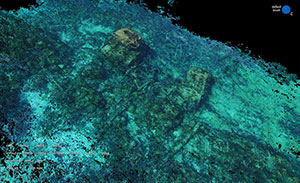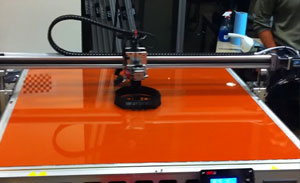The growing acceptance of photogrammetry, Structure from Motion, 3D printing and other tools in cultural heritage engineering makes it increasingly possible to visualize archaeological sites and artifacts in new, rapid and more vivid ways. The Bermuda 100 Challenge taps into the technological pipeline and methodology developed by UC San Diego researchers in the Cultural Heritage Engineering Initiative (CHEI) for documenting heritage assets on land and underwater.
That methodology (depicted right) includes a “toolbox” focused on four stages of discovery, namely:
ACQUISITION
Our diagnostic imaging and analytical diagnostics techniques seek to capture artifact geometry and material composition, important elements for the creation of its digital surrogate that subsequently may be used to further study the artifact and its life cycle. Our toolbox includes a broad range of imaging techniques, algorithms, tools and in-house developed instruments, enabling data acquisition from the micro to the macro scale. The ability to place the right sensor at the right location and at the right time is anchored in applied robotics research, covering a broad spectrum of expertise, related to designing, developing, testing and deploying airborne, terrestrial and submersible robots that are carrying a variety of payloads, ranging from multispectral imaging to physical sample collection or placement. Our research interests in the area of high-speed wireless and wired networks are aimed at creating a digital link between field sites and the research community, enabling rapid exchange of mission-critical data.
EXAMPLE: Photogrammetry
Photogrammetry is the science of making measurements from photographs, especially for recovering the exact positions of surface points. It may also be used to recover the motion pathways of designated reference points on any moving object, on its components, and in the immediately adjacent environment. Photogrammetry is used in different fields, such as topographic mapping, architecture, engineering, geology and archaeology (where it is primarily used to produce plans of large or complex sites rapidly.
PROCESSING
Our research in the area of data processing, storage and access, is pursuing the creation of comprehensive, documented, annotated and most of all trusted data assets that are a critical enabler for data-driven science and engineering. Our team is developing strategies and instruments, including databases and network attached storage appliances for the creation of layered data scaffolds, suitable for real-time, remote analysis and visualization.
EXAMPLE: Structure from Motion (SfM)
Structure from Motion is a photogrammetric range imaging technique for estimating three-dimensional structures from two-dimensional images sequences (notably high-resolution photographs) coupled with local motion signals. SfM grew out of computer vision and visual perception, and effectively allows archaeologists to obtain 3D information from a sequence of 2D images – a major source of 3D computer models and 3D videos available on the Bermuda 100 Challenge website. SfM provides a non-invasive approach for creating a digital replica of an historic structure, and the process is faster and less cumbersome than with traditional surveying techniques.
ANALYSIS
We are pursuing an integrative approach for big-data analytics, creating new algorithms, techniques, and tools for visual computing and visual analytics, where analytical reasoning is enabled through interactive and collaborative data exploration that is facilitated by the cyberinfrastructure that our teams in CHEI, the Qualcomm Institute and the Bermuda 100 Challenge invent for it. Many of our visualization environments literally allow the user to walk into the arena of scientific discovery. Among the visualization and virtual-reality environments that our team has developed are HIPerWall, Vroom, StarCAVE, NexCAVE, TourCAVE, WAVE, WAVElet and 4KAVE, to name a few. These environments, as well as the associated middleware, algorithms and techniques driving them, often become shared-use resources that empower others. Many of these spaces literally allow the user to walk into the arena of scientific discovery. Our research in this area is adopted widely by the scientific community, often copied and made available to universities, government agencies and industry.[ Click here to learn more about the visualization environments for viewing VR content]
DISSEMINATION
The dissemination of research findings, techniques, tools and most of all data, are vital components of our cultural heritage engineering methodology. We are using an integrative paradigm, combining research, development, education and training to create advanced cyber-physical systems suitable for field deployment and use as community tools, while grooming tomorrow’s stewards of world cultural heritage, Crowdsourcing techniques connect to citizen-scientists and scale collaborative data exploration and learning to remarkable levels, while research in the area of 3D printing opens the door to literally hold even the most valuable artifact in the palm of your hand, study it and create new directions for its preservation.
EXAMPLE: 3D Printing
Also known as additive manufacturing, 3D printing creates three-dimensional objects by placing successive layers of resin or other materials under computer control to form the object. In cultural heritage, 3D printing is particularly useful for replicating ancient artifacts because the object can be of almost any shape or geometry that can be developed as a digital model via computer-aided design. 3D printing is now extensively used in cultural heritage for preservation, restoration and dissemination purposes, and many museums use 3D printers to replicate pieces of relics in their collections that may be broken. The Bermuda 100 Challenge will rely on the 3D printing labs in CHEI and the Qualcomm Institute.





